1995 ACURA TL dashboard
[x] Cancel search: dashboardPage 257 of 1771
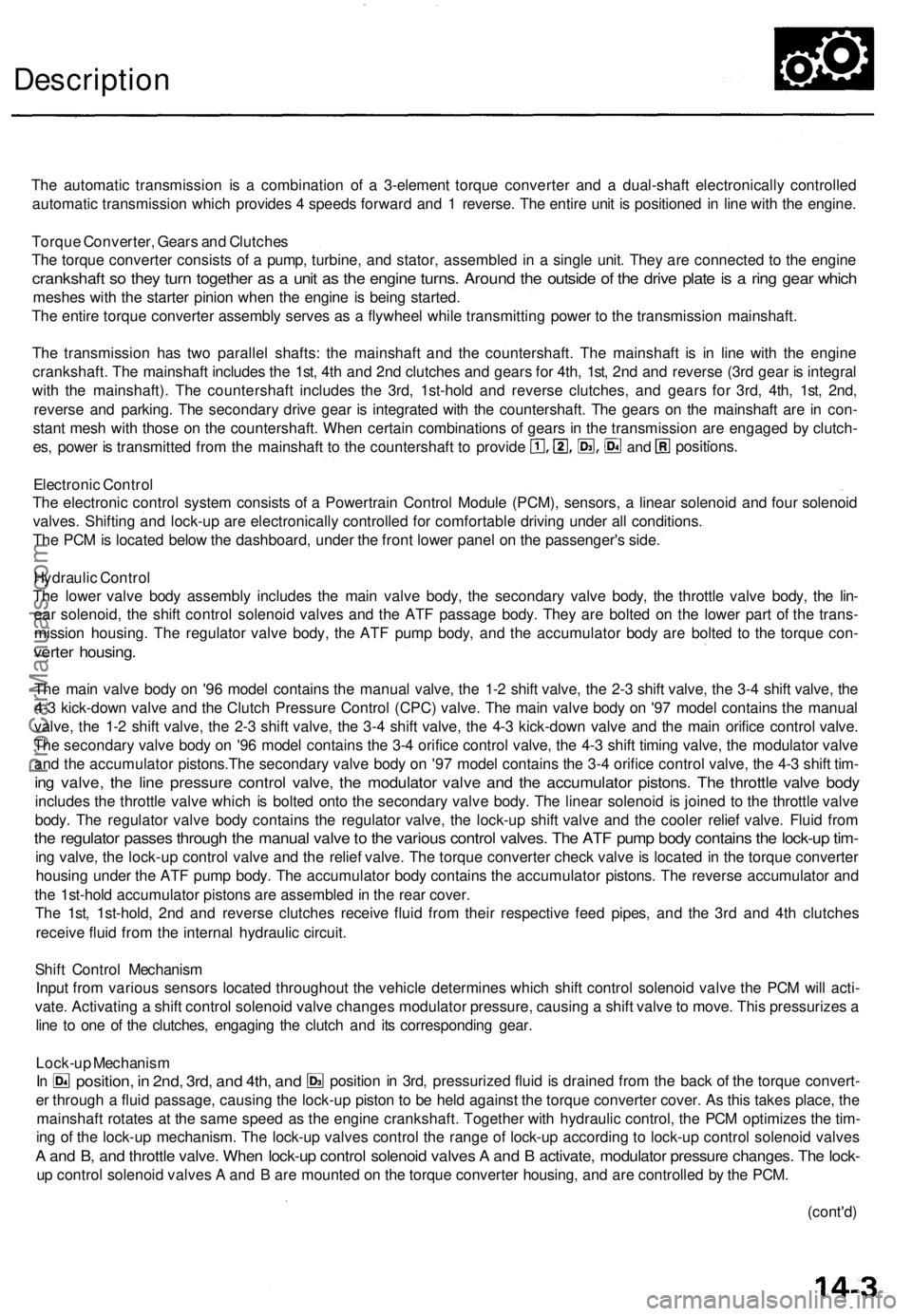
Description
The automatic transmission is a combination of a 3-element torque converter and a dual-shaft electronically controlled
automatic transmission which provides 4 speeds forward and 1 reverse. The entire unit is positioned in line with the engine.
Torque Converter, Gears and Clutches
The torque converter consists of a pump, turbine, and stator, assembled in a single unit. They are connected to the engine
crankshaft so they turn together as a unit as the engine turns. Around the outside of the drive plate is a ring gear which
meshes with the starter pinion when the engine is being started.
The entire torque converter assembly serves as a flywheel while transmitting power to the transmission mainshaft.
The transmission has two parallel shafts: the mainshaft and the countershaft. The mainshaft is in line with the engine
crankshaft. The mainshaft includes the 1st, 4th and 2nd clutches and gears for 4th, 1st, 2nd and reverse (3rd gear is integral
with the mainshaft). The countershaft includes the 3rd, 1st-hold and reverse clutches, and gears for 3rd, 4th, 1st, 2nd,
reverse and parking. The secondary drive gear is integrated with the countershaft. The gears on the mainshaft are in con-
stant mesh with those on the countershaft. When certain combinations of gears in the transmission are engaged by clutch-
positions.
and
es, power is transmitted from the mainshaft to the countershaft to provide
Electronic Control
The electronic control system consists of a Powertrain Control Module (PCM), sensors, a linear solenoid and four solenoid
valves. Shifting and lock-up are electronically controlled for comfortable driving under all conditions.
The PCM is located below the dashboard, under the front lower panel on the passenger's side.
Hydraulic Control
The lower valve body assembly includes the main valve body, the secondary valve body, the throttle valve body, the lin-
ear solenoid, the shift control solenoid valves and the ATF passage body. They are bolted on the lower part of the trans-
mission housing. The regulator valve body, the ATF pump body, and the accumulator body are bolted to the torque con-
verter housing.
The main valve body on '96 model contains the manual valve, the 1-2 shift valve, the 2-3 shift valve, the 3-4 shift valve, the
4-3 kick-down valve and the Clutch Pressure Control (CPC) valve. The main valve body on '97 model contains the manual
valve, the 1-2 shift valve, the 2-3 shift valve, the 3-4 shift valve, the 4-3 kick-down valve and the main orifice control valve.
The secondary valve body on '96 model contains the 3-4 orifice control valve, the 4-3 shift timing valve, the modulator valve
and the accumulator pistons.The secondary valve body on '97 model contains the 3-4 orifice control valve, the 4-3 shift tim-
ing valve, the line pressure control valve, the modulator valve and the accumulator pistons. The throttle valve body
includes the throttle valve which is bolted onto the secondary valve body. The linear solenoid is joined to the throttle valve
body. The regulator valve body contains the regulator valve, the lock-up shift valve and the cooler relief valve. Fluid from
the regulator passes through the manual valve to the various control valves. The ATF pump body contains the lock-up tim-
ing valve, the lock-up control valve and the relief valve. The torque converter check valve is located in the torque converter
housing under the ATF pump body. The accumulator body contains the accumulator pistons. The reverse accumulator and
the 1st-hold accumulator pistons are assembled in the rear cover.
The 1st, 1st-hold, 2nd and reverse clutches receive fluid from their respective feed pipes, and the 3rd and 4th clutches
receive fluid from the internal hydraulic circuit.
Shift Control Mechanism
Input from various sensors located throughout the vehicle determines which shift control solenoid valve the PCM will acti-
vate. Activating a shift control solenoid valve changes modulator pressure, causing a shift valve to move. This pressurizes a
line to one of the clutches, engaging the clutch and its corresponding gear.
er through a fluid passage, causing the lock-up piston to be held against the torque converter cover. As this takes place, the
mainshaft rotates at the same speed as the engine crankshaft. Together with hydraulic control, the PCM optimizes the tim-
ing of the lock-up mechanism. The lock-up valves control the range of lock-up according to lock-up control solenoid valves
A and B, and throttle valve. When lock-up control solenoid valves A and B activate, modulator pressure changes. The lock-
up control solenoid valves A and B are mounted on the torque converter housing, and are controlled by the PCM.
(cont'd)
Lock-up Mechanism
In
position, in 2nd, 3rd, and 4th, and
position in 3rd, pressurized fluid is drained from the back of the torque convert-ProCarManuals.com
Page 273 of 1771
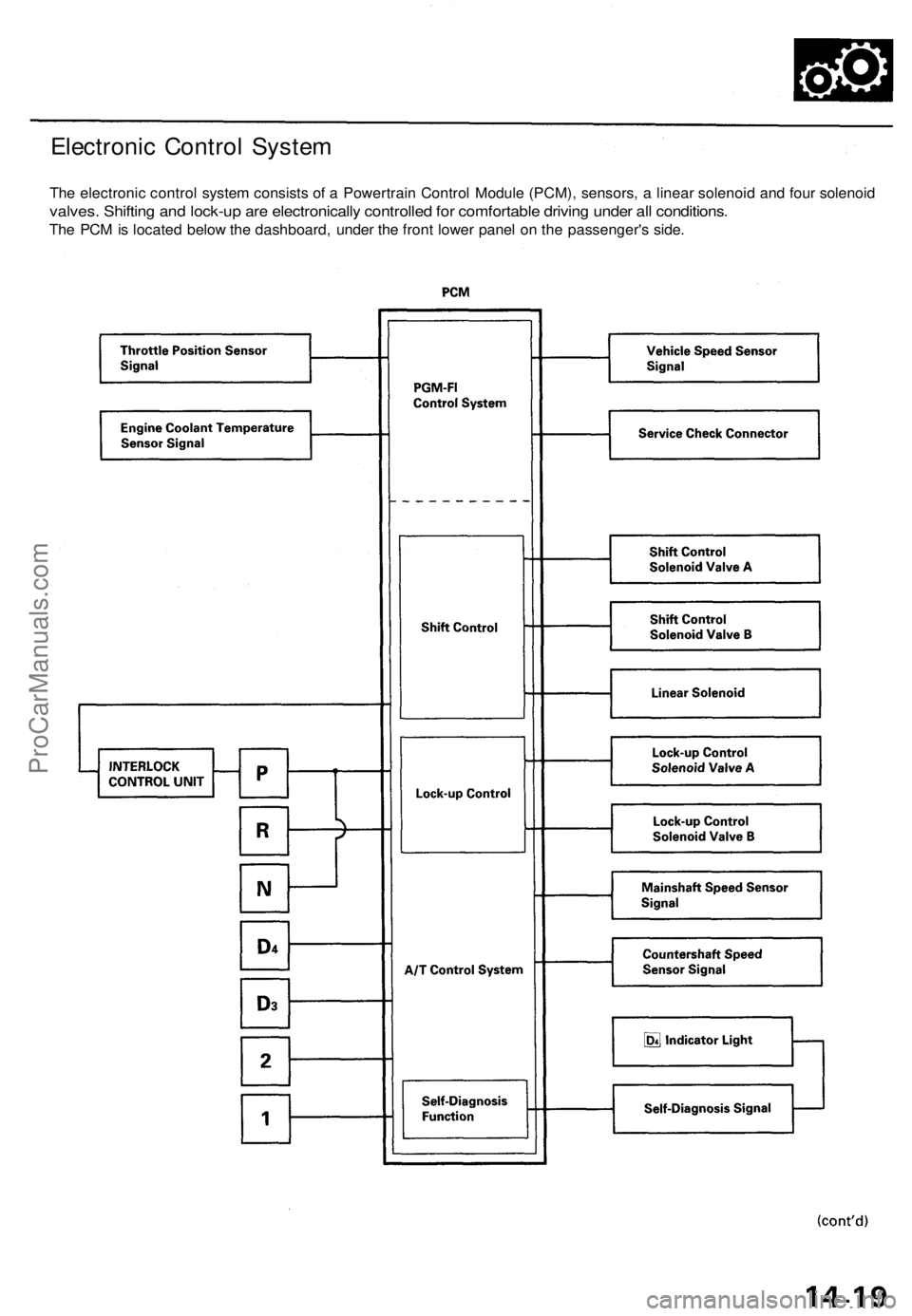
Electronic Control System
The electronic control system consists of a Powertrain Control Module (PCM), sensors, a linear solenoid and four solenoid
valves. Shifting and lock-up are electronically controlled for comfortable driving under all conditions.
The PCM is located below the dashboard, under the front lower panel on the passenger's side.ProCarManuals.com
Page 575 of 1771
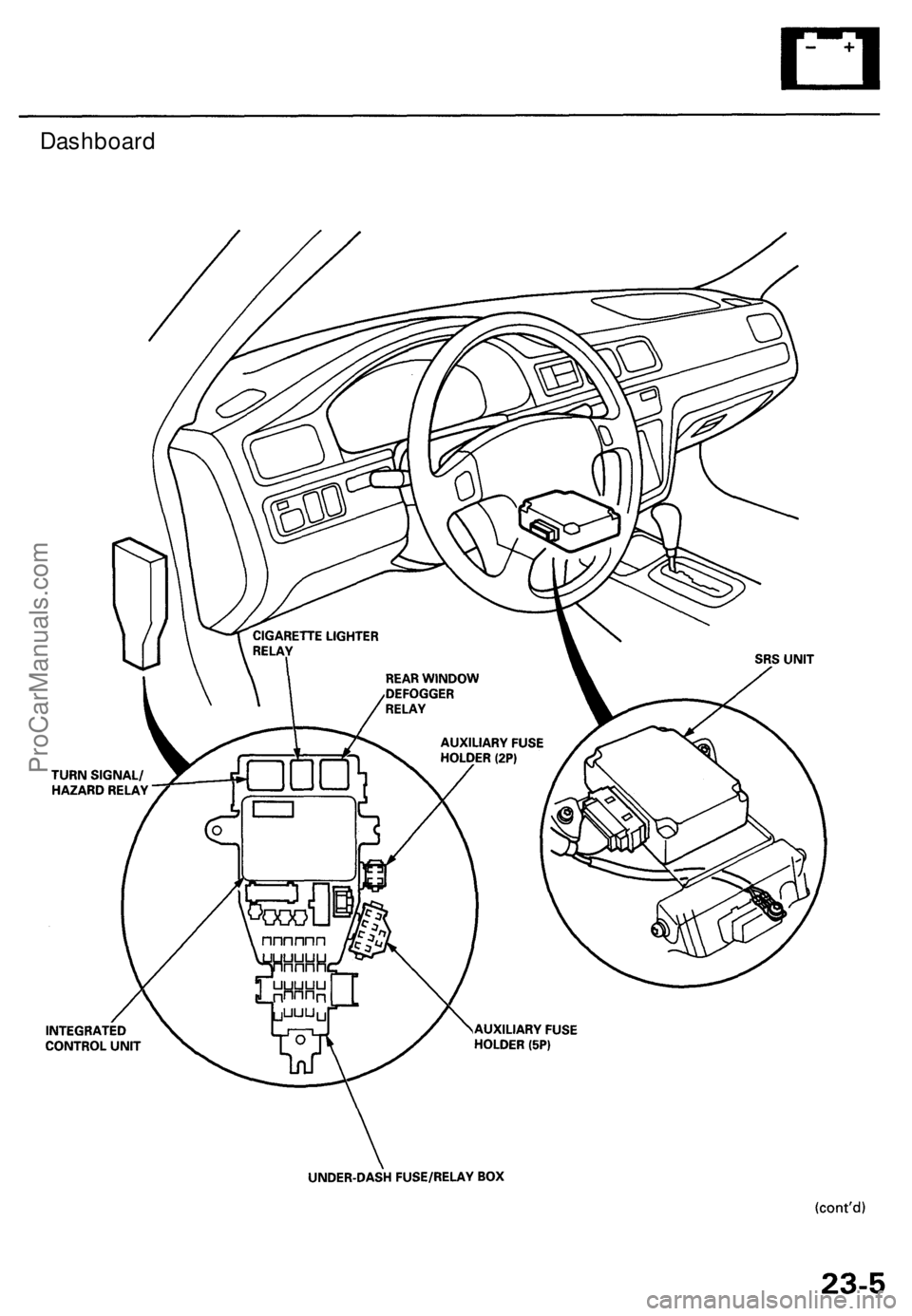
Dashboard
ProCarManuals.com
Page 646 of 1771
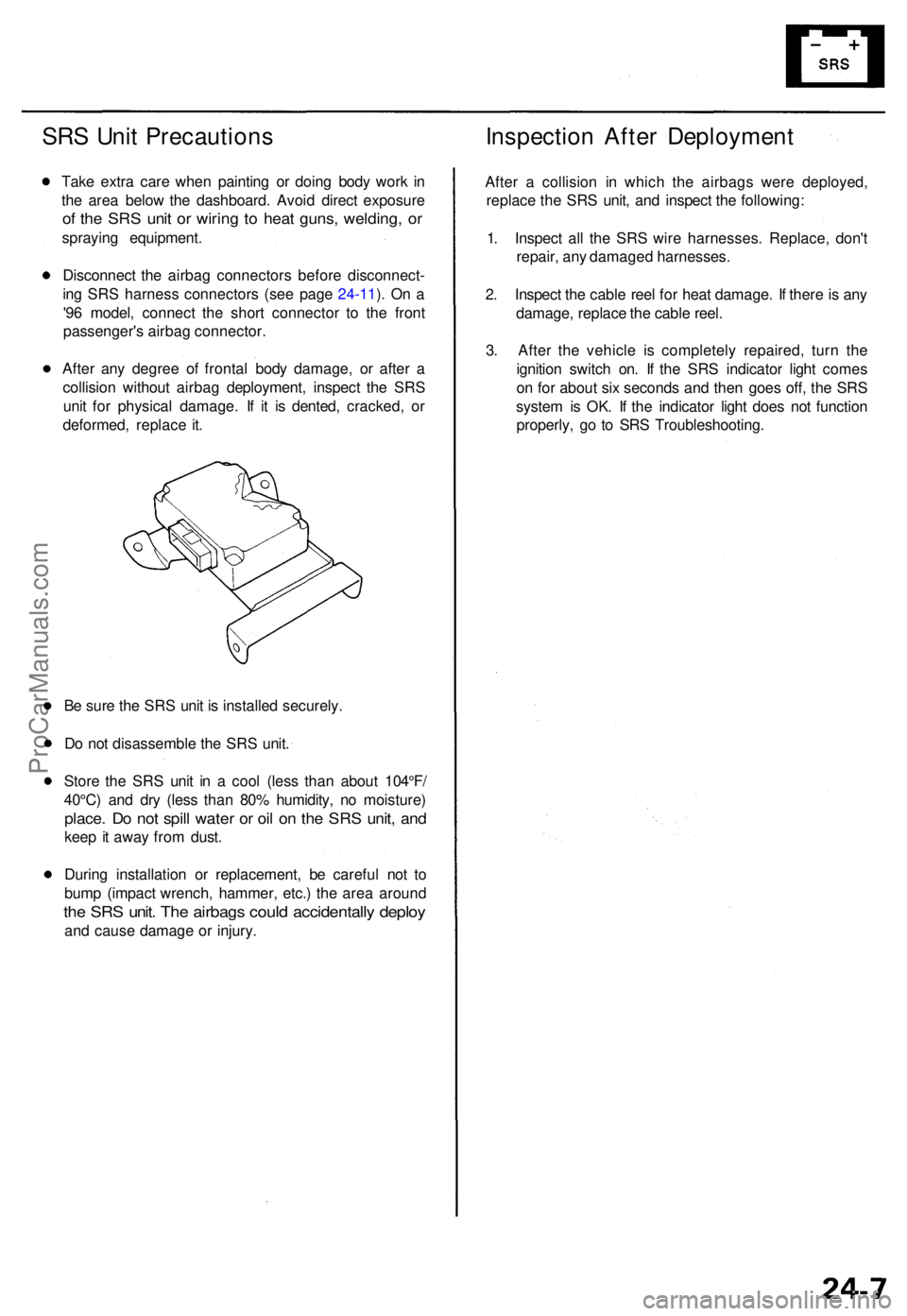
SRS Uni t Precaution s
Take extr a car e whe n paintin g o r doin g bod y wor k i n
th e are a belo w th e dashboard . Avoi d direc t exposur e
of th e SR S uni t o r wirin g t o hea t guns , welding , o r
sprayin g equipment .
Disconnec t th e airba g connector s befor e disconnect -
in g SR S harnes s connector s (se e pag e 24-11 ). O n a
'9 6 model , connec t th e shor t connecto r t o th e fron t
passenger' s airba g connector .
Afte r an y degre e o f fronta l bod y damage , o r afte r a
collisio n withou t airba g deployment , inspec t th e SR S
uni t fo r physica l damage . I f i t i s dented , cracked , o r
deformed , replac e it .
B e sur e th e SR S uni t i s installe d securely .
D o no t disassembl e th e SR S unit .
Stor e th e SR S uni t i n a coo l (les s tha n abou t 104°F /
40°C ) an d dr y (les s tha n 80 % humidity , n o moisture )
place. D o no t spil l wate r o r oi l o n th e SR S unit , an d
kee p it awa y fro m dust .
Durin g installatio n o r replacement , b e carefu l no t t o
bum p (impac t wrench , hammer , etc. ) th e are a aroun d
the SR S unit . Th e airbag s coul d accidentall y deplo y
and caus e damag e o r injury .
Inspectio n Afte r Deploymen t
After a collisio n i n whic h th e airbag s wer e deployed ,
replac e th e SR S unit , an d inspec t th e following :
1 . Inspec t al l th e SR S wir e harnesses . Replace , don' t
repair , an y damage d harnesses .
2 . Inspec t th e cabl e ree l fo r hea t damage . I f ther e is an y
damage , replac e th e cabl e reel .
3 . Afte r th e vehicl e i s completel y repaired , tur n th e
ignitio n switc h on . I f th e SR S indicato r ligh t come s
o n fo r abou t si x second s an d the n goe s off , th e SR S
syste m is OK . I f th e indicato r ligh t doe s no t functio n
properly , g o t o SR S Troubleshooting .
ProCarManuals.com
Page 657 of 1771
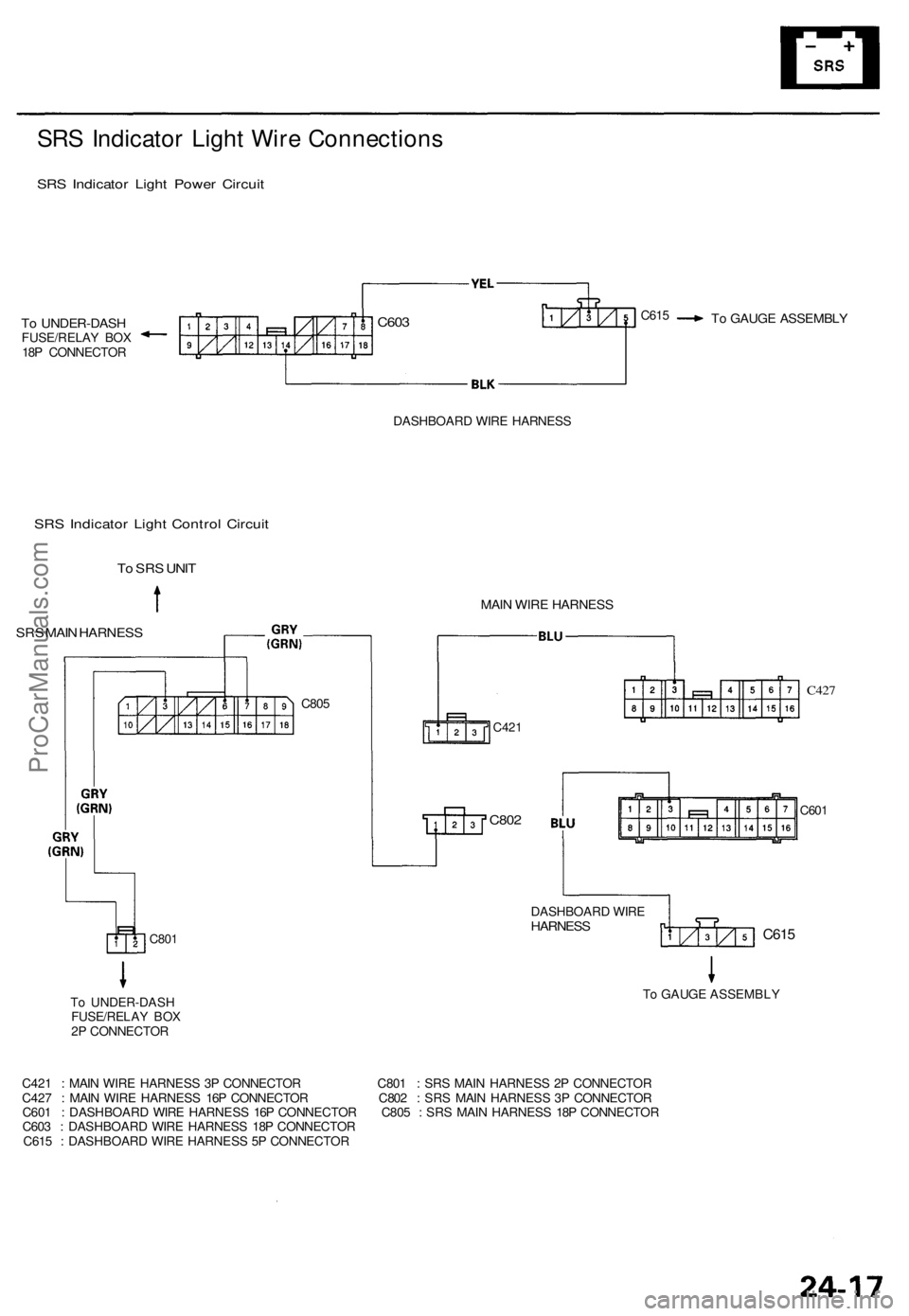
SRS Indicato r Ligh t Wir e Connection s
SRS Indicato r Ligh t Powe r Circui t
To UNDER-DAS HFUSE/RELAY BO X
18 P CONNECTO R
To GAUG E ASSEMBL Y
DASHBOAR D WIR E HARNES S
SRS Indicato r Ligh t Contro l Circui t
To SR S UNI T
SRS MAI N HARNES S
C801
To UNDER-DAS H
FUSE/RELA Y BO X
2 P CONNECTO R
C421
C427
C60 1
C42 1 : MAI N WIR E HARNES S 3 P CONNECTO R C80 1 : SR S MAI N HARNES S 2 P CONNECTO R
C42 7 : MAI N WIR E HARNES S 16 P CONNECTO R C80 2 : SR S MAI N HARNES S 3 P CONNECTO R
C60 1 : DASHBOAR D WIR E HARNES S 16 P CONNECTO R C80 5 : SR S MAI N HARNES S 18 P CONNECTO R
C60 3 : DASHBOAR D WIR E HARNES S 18 P CONNECTO R
C61 5 : DASHBOAR D WIR E HARNES S 5 P CONNECTO R
C615
C802
MAIN WIR E HARNES S
C805
DASHBOARD WIR E
HARNES S
C615C60 3
To GAUG E ASSEMBL Y
ProCarManuals.com
Page 659 of 1771
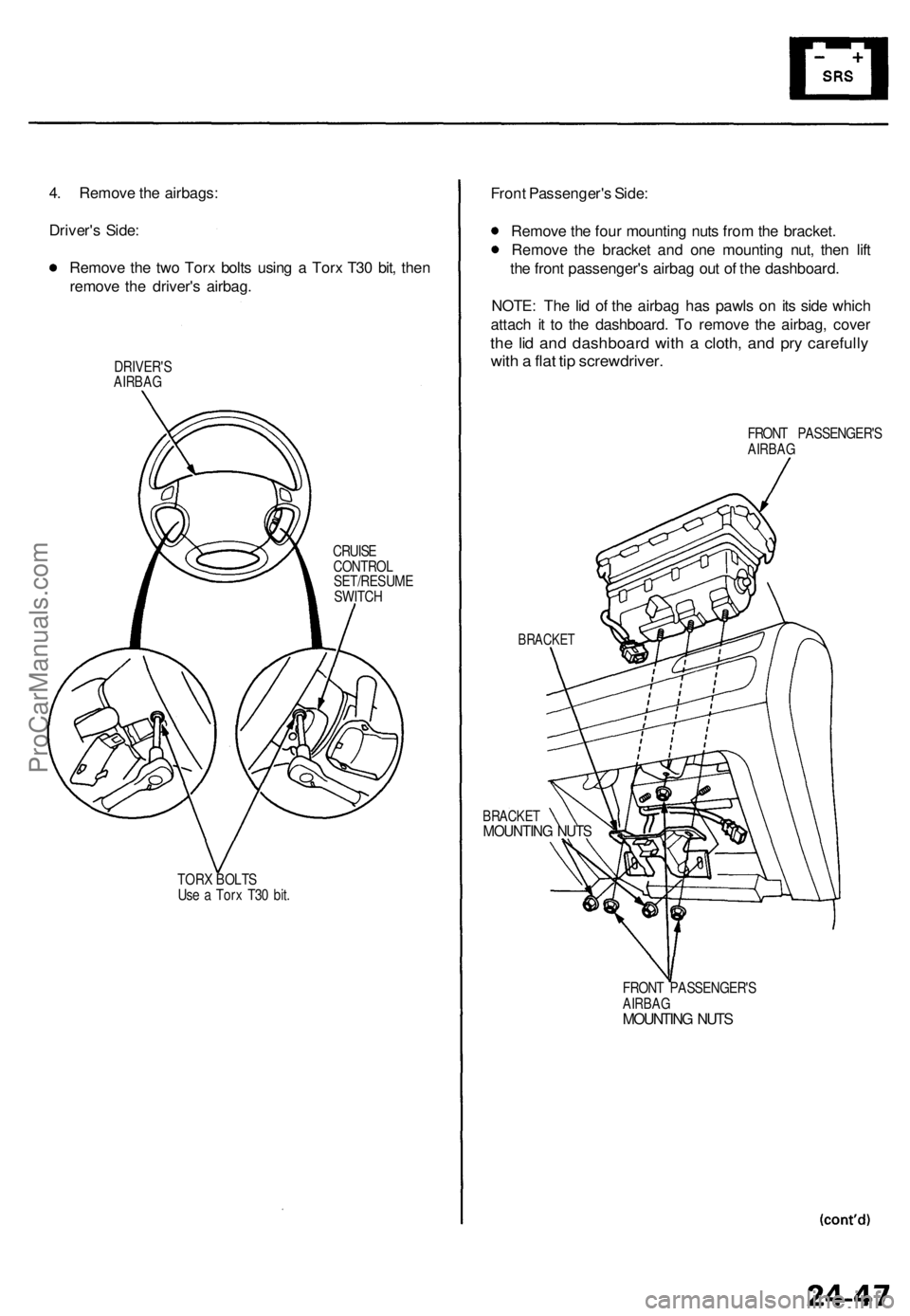
4. Remove the airbags:
Driver's Side:
Remove the two Torx bolts using a Torx T30 bit, then
remove the driver's airbag.
DRIVER'S
AIRBAG
CRUISE
CONTROL
SET/RESUME
SWITCH
TORX BOLTS
Use a Torx T30 bit.
Front Passenger's Side:
Remove the four mounting nuts from the bracket.
Remove the bracket and one mounting nut, then lift
the front passenger's airbag out of the dashboard.
NOTE: The lid of the airbag has pawls on its side which
attach it to the dashboard. To remove the airbag, cover
the lid and dashboard with a cloth, and pry carefully
with a flat tip screwdriver.
FRONT PASSENGER'S
AIRBAG
BRACKET
BRACKET
MOUNTING NUTS
FRONT PASSENGER'S
AIRBAG
MOUNTING NUTSProCarManuals.com
Page 667 of 1771
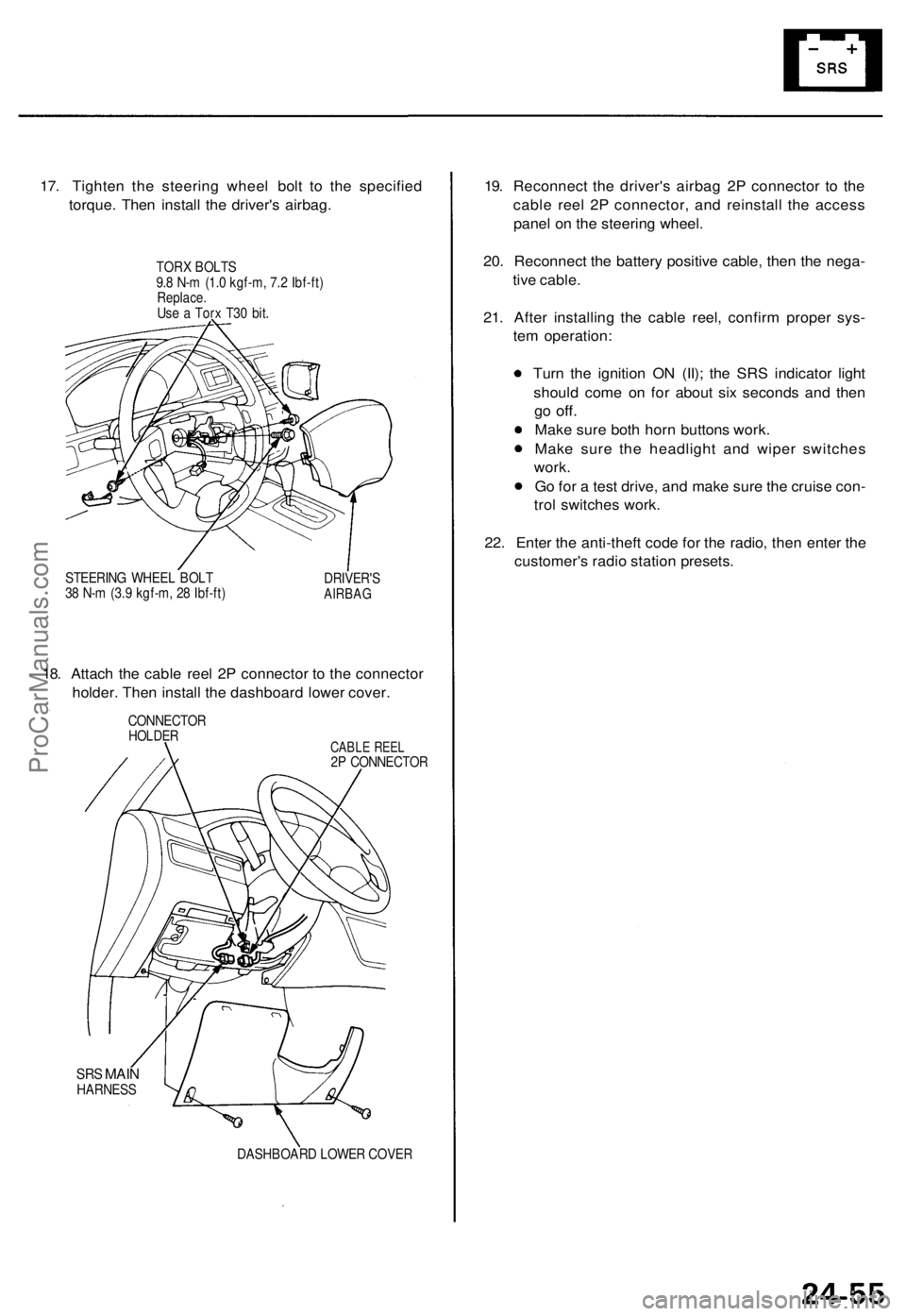
17. Tighten the steering wheel bolt to the specified
torque. Then install the driver's airbag.
TORX BOLTS
9.8 N-m (1.0 kgf-m, 7.2 Ibf-ft)
Replace.
Use a Torx T30 bit.
STEERING WHEEL BOLT
38 N-m (3.9 kgf-m, 28 Ibf-ft)
DRIVER'S
AIRBAG
18. Attach the cable reel 2P connector to the connector
holder. Then install the dashboard lower cover.
CONNECTOR
HOLDER
CABLE REEL
2P CONNECTOR
SRS
MAIN
HARNESS
DASHBOARD LOWER COVER
19. Reconnect the driver's airbag 2P connector to the
cable reel 2P connector, and reinstall the access
panel on the steering wheel.
20. Reconnect the battery positive cable, then the nega-
tive cable.
21. After installing the cable reel, confirm proper sys-
tem operation:
Turn the ignition ON (II); the SRS indicator light
should come on for about six seconds and then
go
off.
Make sure both horn buttons work.
Make sure the headlight and wiper switches
work.
Go for a test drive, and make sure the cruise con-
trol switches work.
22. Enter the anti-theft code for the radio, then enter the
customer's radio station presets.ProCarManuals.com
Page 668 of 1771
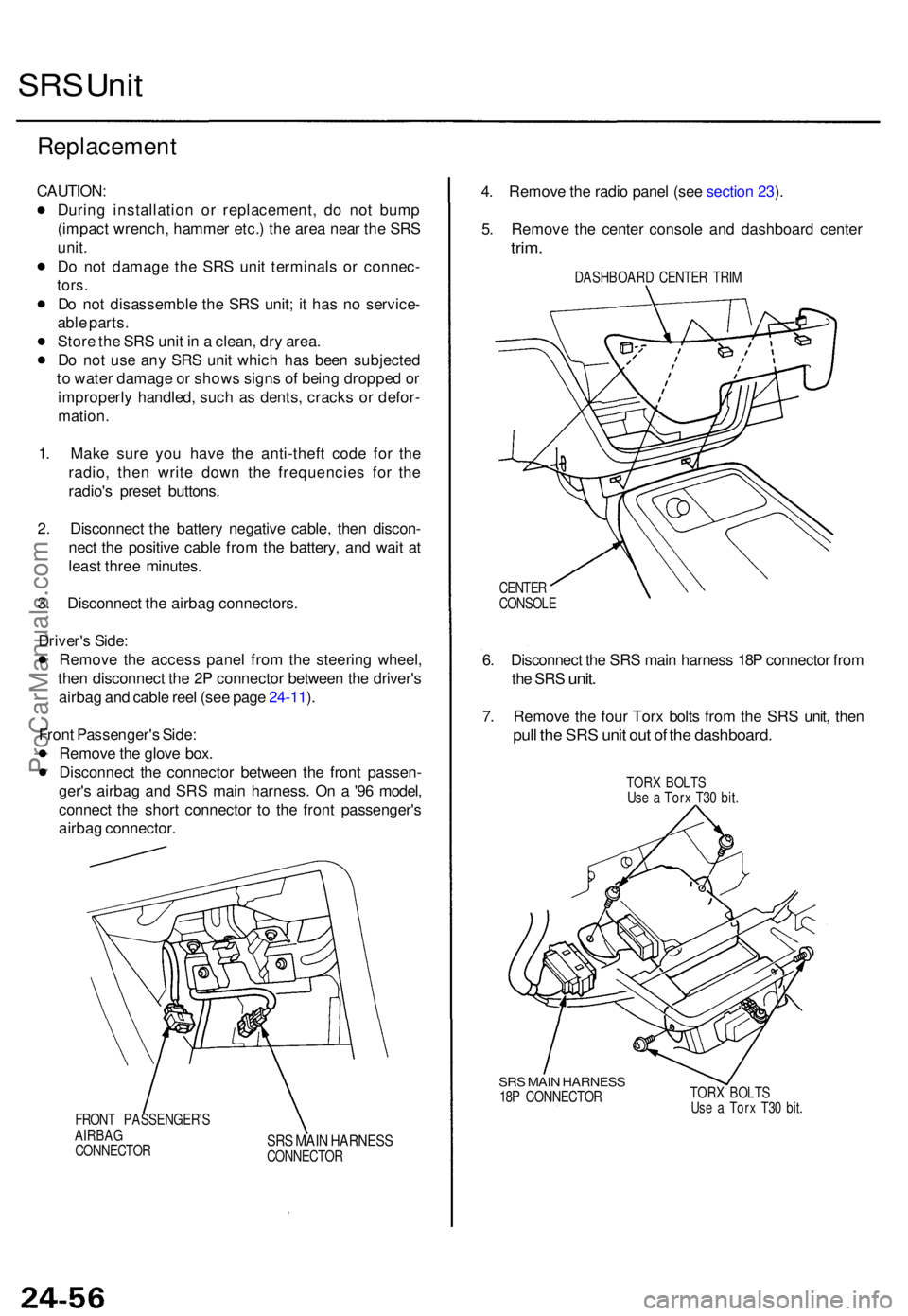
SRS Uni t
Replacemen t
CAUTION:
Durin g installatio n o r replacement , d o no t bum p
(impac t wrench , hamme r etc. ) th e are a nea r th e SR S
unit .
D o no t damag e th e SR S uni t terminal s o r connec -
tors.
Do no t disassembl e th e SR S unit ; i t ha s n o service -
abl e parts .
Stor e th e SR S uni t i n a clean , dr y area .
D o no t us e an y SR S uni t whic h ha s bee n subjecte d
t o wate r damag e o r show s sign s o f bein g droppe d o r
improperl y handled , suc h a s dents , crack s o r defor -
mation .
1 . Mak e sur e yo u hav e th e anti-thef t cod e fo r th e
radio , the n writ e dow n th e frequencie s fo r th e
radio' s prese t buttons .
2 . Disconnec t th e batter y negativ e cable , the n discon -
nec t th e positiv e cabl e fro m th e battery , an d wai t a t
leas t thre e minutes .
3 . Disconnec t th e airba g connectors .
Driver' s Side :
Remov e th e acces s pane l fro m th e steerin g wheel ,
the n disconnec t th e 2 P connecto r betwee n th e driver' s
airba g an d cabl e ree l (se e pag e 24-11 ).
Fron t Passenger' s Side :
Remov e th e glov e box .
Disconnec t th e connecto r betwee n th e fron t passen -
ger' s airba g an d SR S mai n harness . O n a '9 6 model ,
connec t th e shor t connecto r t o th e fron t passenger' s
airba g connector .
FRONT PASSENGER' S
AIRBA G
CONNECTO R
SRS MAI N HARNES SCONNECTO R
4. Remov e th e radi o pane l (se e sectio n 23 ).
5 . Remov e th e cente r consol e an d dashboar d cente r
trim.
DASHBOAR D CENTE R TRI M
CENTE R
CONSOL E
6. Disconnec t th e SR S mai n harnes s 18 P connecto r fro m
th e SR S
unit .
7. Remov e th e fou r Tor x bolt s fro m th e SR S unit , the n
pull th e SR S uni t ou t o f th e dashboard .
TORX BOLT S
Us e a Tor x T3 0 bit .
SRS MAI N HARNES S18P CONNECTO R TOR
X BOLT SUse a Tor x T3 0 bit .
ProCarManuals.com